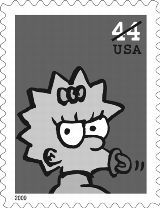The 2009 stamp program continued the long tradition of issuing postage stamps that are unique, functional, educational, and entertaining. Of the 30 billion stamps, stamped envelopes, and stamped cards produced this year, 2.5 percent were part of the commemorative stamps program. These stamps paid tribute to the people and events that have shaped the United States. Subjects in 2009 included tributes to Abraham Lincoln, four Supreme Court Justices, Edgar Allen Poe, Gary Cooper, Anna Julia Cooper, and Bob Hope. Other commemoratives saluted statehood anniversaries for Alaska, Hawaii, and Oregon, the America’s Gulf Coast Lighthouses, the Lunar New Year celebrations, the animation of the Simpsons, and the Thanksgiving Day Parades. Two special panes of stamps, Civil Rights Pioneers and Early Television Memories, were also issued.
New this year was the addition of the Forever stamp format to the personalized stamped envelope program. Business and residential customers can purchase a variety of stamped envelopes that include a Forever stamp, along with their name and return address. Personalized envelopes can be easily ordered at usps.com.

Maggie received 272,000 votes edging out Homer in an online "Favorite Simpsons Stamp" contest.
Most ideas for the commemorative stamp program come from the American public. Each year 50,000 ideas are submitted for consideration by the Citizens’ Stamp Advisory Committee, a cross section of designers, historians, and educators, who narrow the selection of stamp subjects to be issued. The Committee reviews the suggestions and makes recommendations to the Postmaster General for final approval. The time between submitting a stamp idea and issuing the stamp can take several years of deliberate discussion and design. Information about the program can be found at usps.com/communications/organization/csac.htm.
In addition to using stamps to commemorate people, events, and places, the Postal Service also issues stamps to fund causes mandated by Congress. The Postal Service currently offers one 55-cent fundraising or semipostal stamp for purchase: the Breast Cancer Research stamp. Since its release in 1998, the Postal Service has sold more than 866 million stamps and raised more than $67.8 million for breast cancer research. The price of a semipostal stamp pays for the First-Class Mail single-piece postage price in effect at the time of purchase, plus an amount to fund the cause. By law, 70 percent of the net amount raised is given to the National Institutes of Health and 30 percent is given to the Medical Research Program at the Department of Defense.
